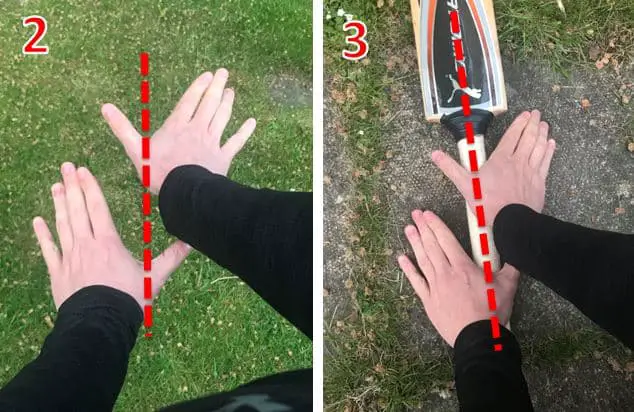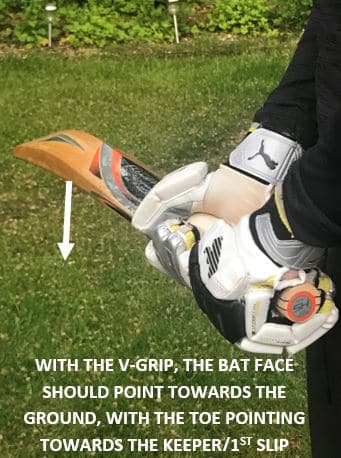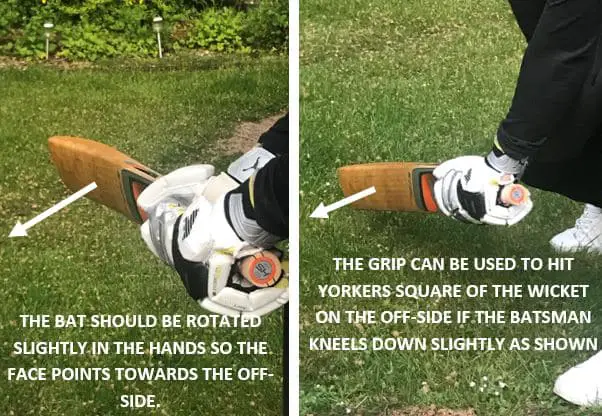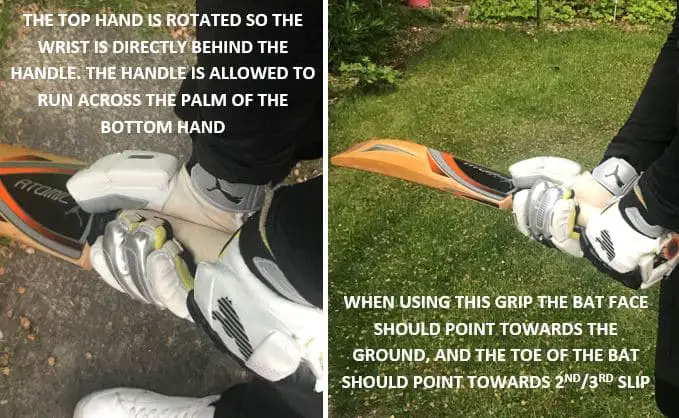The way we grip the cricket bat forms the foundation of a good batting technique! Even just a slight change to your grip can affect many things, such as our ability to play shots through the off-side, leg-side, and our ability to keep the ball down rather than hitting it up in the air. In this post I’ll break down all of the main ways that batsmen grip the bat, detailing the advantages and disadvantages of each! Hopefully this will help any of you that are struggling with this part of your game make a decision on how you want to play!
So, how do you hold a cricket bat correctly?
There are multiple different grips, but the one that is most commonly used is the conventional ‘V-Grip’. This grip requires you to align both of your hands along the back of the bat handle so that the gap between your thumbs and index fingers create two separate V shapes. Other grips that are also used are the closed face grip, the open face grip and the Bradman grip.
Now let’s dive into these in a bit more detail and look at the advantages and disadvantages of each!
Conventional V-Grip
This is how the majority of batsmen will hold the bat, and if you’re a newcomer to the game of cricket, you should definitely start by using this grip! It is the most neutral position and the main advantage of it is that it allows you to play shots comfortably on all sides of the wicket. Younger or less experienced players don’t need to experiment with their grip too much straight away. Instead, I’d recommend starting with the conventional V grip and focus on building a solid technique!
To make sure you’re getting your hands in the right position for the V-grip, all you have to do is stick to this useful little guide:
- Lay your cricket bat on the ground with the face of the bat pointing downwards, and the handle pointing directly towards you.
- Hold your hands out in front of you and create the V shapes by positioning your thumbs in the way I’ve shown in picture 2 below. Right handed batsmen should have their right hand on top, whereas left handers should have their left hand on top. The V’s on each hand should line up with each other. Imagine there is a line connecting them!
- Bend down whilst keeping your hands in this position and place them on the back of the bat handle like I’m demonstrating in picture 3 below. Make sure there is a small gap between them! The V shapes created by the position of your hands should now line up with the middle of the back of the bat.
- Once your hands are in position on the back of the handle, wrap your fingers around it and pick up the bat.

When you have your hands on the bat, try to make sure that you’re not holding it too tightly. For the conventional V grip, the bottom hand should be kept fairly loose, making it easy for you to play shots on all sides of the wicket. When you pick the bat up, this grip should result in the bat face pointing down towards the ground, with the toe of the bat pointing in the direction of the wicketkeeper/1st slip. You can look at the photos below to check this!

Advantages: Allows you to play shots easily on all sides of the wicket
Disadvantages: None
Closed Face Grip
Certain batsmen find it a lot easier to play through the leg side than the off side. More often than not, this will be because the way they grip the bat causes them to angle the face of the bat slightly towards the leg-side! This is also referred to as ‘closing the face’ of the bat. One of the best examples of this I can think of is Graeme Smith, the ex-captain of South Africa. When you watched Smith bat, you could clearly see that the bat face was slightly closed even when he was in his batting stance. As he brought his bat through to play straight down the ground, it was even more noticeable. Although Smith was very strong through the off side too, the majority of his runs came through the leg side, and this technique served him extremely well. So how exactly did his grip differ from the conventional V grip?
The main difference between the two is that the closed face grip requires you to grip the bat more forcefully with your bottom hand. This is why you’ll often hear commentators say that a batsman with a technique like this has a ‘strong bottom hand grip’. As I mentioned in the previous section, the conventional V grip requires the bottom hand to be kept fairly loose, allowing the bat to be rotated freely and making it easier for you to angle the face of the bat towards the off side. When you grip the bat tightly with your bottom hand, it is much harder to then angle the bat towards the off side, specifically the cover region. Try it and see how difficult it is for yourself if you don’t believe me!
The closed face grip isn’t really something that batsmen choose to adopt suddenly. It is more often something that develops naturally over time because the player in question feels comfortable with it! If you’re a batsman who already uses this grip, or who is looking to try it, then trust me, you can be successful with it! Players like Graeme Smith are proof of that! You may come under pressure from coaches that want to try and change your technique to make it more ‘technically correct’, but if the closed face grip works for you, don’t feel like you have to make any adjustments!
Advantages: Mastering this technique will usually lead to you being more comfortable playing shots through the leg-side.
Disadvantages: May harm your ability to play through the off-side. You will probably have to be smarter with regards to which deliveries you play at outside the off-stump!
Open Face Grip
This grip isn’t used that often, and it usually isn’t something that a batsman will base their entire technique upon. Instead, it is usually used at certain points in matches when batsmen need to get creative to score runs! Batsmen like Jos Buttler use this grip specifically against bowlers who are bowling a lot of yorkers, as it allows them to hit these types of deliveries square of the wicket on the off side. Buttler explains that it is impossible to hit a yorker out of the middle of your bat if you’re playing with a vertical bat! Playing with a horizontal bat and using the open face grip gives you a much better chance of getting the middle of the bat on to a yorker!
If you want to use the open face grip, then the approach is really quite simple. All you have to do is rotate the bat slightly in your hands as the bowler is running in to bowl. It does not have to be rotated much, just enough that you expose the face of the bat to the off side of the field. Check the photos below to see how the open face grip should look!

As I’ve already mentioned, this shouldn’t be something that you’re trying to do regularly, as it severely compromises your ability to play deliveries on the leg-side. But using it at the right time can allow you to score runs against deliveries that might usually be extremely hard to hit. I’ve written a lot more about this grip, as well as other ways that you can attack the yorker in my ultimate guide to batting against the yorker post here! In my view, having a plan of how you are going to attack the yorker is key to being a great batsman in modern day cricket, so if you’re interested in learning some new methods then check that post out!
Advantages: Allows you to hit incredibly full deliveries square of the wicket on the off-side
Disadvantages: This grip cannot really be used 100% of the time. It severely harms your ability to play the ball through the leg-side.
Don Bradman’s Grip
Don Bradman is the best batsman who ever lived, by a wide margin. However, because he played so long ago, in the early part of the 1900’s, there is nowhere near as much footage of him batting as there is of modern players! Had Bradman been playing now, we would see far more players copying every aspect of his slightly unorthodox batting technique, because it made him incredibly successful!
One of the aspects of his technique that contributed to the success was the way he gripped the bat. There aren’t many players who have even come close to replicating it since Bradman retired. If you’d like to try his grip for yourself, then here’s how you should do it:
- Lay your cricket bat on the ground with the face of the bat pointing downwards, and the handle pointing directly towards you.
- Pick up the bat using the conventional V grip, which I outlined earlier in this post.
- Once your hands are in the V grip position, rotate your bottom hand so that it goes underneath the bat. Also, rotate your top hand slightly so that your wrist is now directly behind the handle of the bat.
If you’re unsure of what step 3 should look like, I’m demonstrating it for you in the photos below!

You will hear a lot of coaches tell you that during the pick-up phase of a shot (the point at which you lift the bat off the ground and prepare to play a shot), your bat must be pointing directly behind you, towards the wicketkeeper. However, that is not the only way you can be successful! Adopting Bradman’s grip will cause you to point the bat in the direction of second/third slip during the pick-up phase. This means that in order to bring the bat through in a straight line to play a straight drive you must perform a slightly circular motion in mid-air. This is why Bradman’s technique is often referred to as the ‘rotary technique’!
One of the big advantages of using this grip is that you will automatically roll your wrists as you make contact with the ball when playing cross-batted shots such as the hook or the square cut. This is entirely down to the shift in position of the bottom hand. As many of you will know, rolling your wrists as you play cross-batted shots helps us to hit the ball along the ground rather than up in the air, meaning we will offer less catching opportunities to the opposing team!
The grip also allowed Bradman to play leg-side shots incredibly easily. This is because the position of the hands on the bat naturally caused the face of the bat to close towards the leg side. However, it should be noted that Bradman also said that the grip handicapped him when he was trying to play shots through the mid-off and point region.
If you decide to add this grip to your game, then you have to make sure you fully commit to using it. This can’t be something that you just choose to do during the odd practice session! It takes time to become comfortable with your own technique and even more time to learn how to use it against all different types of bowlers. You’ll have to put in a lot of hours during net sessions, but like any cricket skill, it can be mastered if you devote enough time to it. If Bradman’s grip feels comfortable to you, then try using it more regularly and see if it makes a difference to your batting.
Advantages: This grip causes you to roll your wrists naturally on cross-batted shots, allowing you to keep the ball down. Also makes it very easy to play shots through the leg-side.
Disadvantages: The grip can feel incredibly unnatural to some players. The grip can also make it very difficult to play shots through the off-side.
How High Should You Grip A Cricket Bat Handle?
Like most things in cricket, there isn’t a ‘one size fits all’ approach to how high you should be placing your hands on the cricket bat handle! Some players prefer to have their hands further towards the top of the handle, like legendary Australia wicketkeeper Adam Gilchrist. A lot of people believed that this was one of the reasons he was able to hit the ball as hard and as far as he regularly did! However, Gilchrist says that he held the bat this high simply because it felt the most natural to him. Ricky Ponting held the bat a bit lower on the handle, because he believed that this allowed him to control the bat a lot better.
If you’re just starting out on your cricketing journey and you’re unsure how high to place your hands on the handle, I’d recommend starting by placing them close to the middle. Remember that there should be a small gap between the hands! This is the most neutral position and means that you can always move your hands slightly up or down the handle in future depending on what feels best for you. I think my grip is fairly central on the bat, and this has always felt perfectly fine for me!
Conclusion
If you have any other questions relating to the way batsmen grip the bat that I didn’t manage to cover here, feel free to write them in a comment below and I’ll do my best to answer them! Also, comment what you would like to see me cover in future posts! Other than that I hope you’ve enjoyed your time on the site and I hope you’d consider returning in the future!
